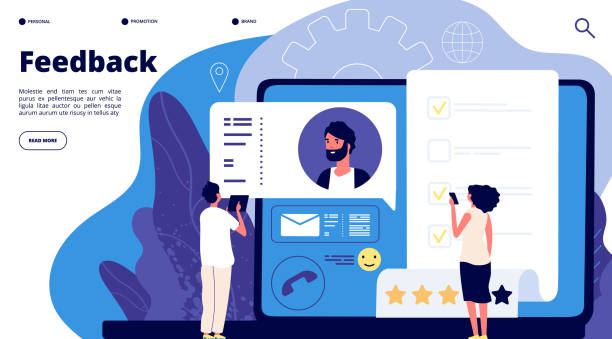Introduction to Responsive Website Design and Its Importance in the Current Era

In today’s world, where technology is advancing at a breathtaking pace and internet access through various devices has become commonplace, the concept of #Responsive_Web_Design has gained more importance than ever.
#User_Experience and #Mobile have become the focus of web developers, and it is no longer possible to design a website solely for correct display on desktop screens.
Responsive website design refers to an approach that enables websites and applications to automatically adjust their layout and elements to the screen size of the user’s device.
This automatic adaptability ensures a seamless and optimized user experience, without the user needing to horizontal scroll or zoom to view content.
From small smartphones to tablets, laptops, and even smart TVs, every device requires a unique display, and a responsive website addresses this need.
The importance of this approach is not limited to visual aesthetics; it directly impacts conversion rates, user dwell time on the site, and improved search engine rankings.
A website that cannot be displayed properly on various devices will not only lose its users but will also gradually lose its digital credibility.
Therefore, investing in responsive website design is a strategic necessity for any business or individual seeking success in the online space.
Are you tired of your company’s website not being seen as it deserves, and losing potential customers? Solve this problem forever with professional and effective website design by Rasawab!
✅ Increase brand credibility and gain customer trust
✅ Attract targeted sales leads
⚡ Contact us now for a free consultation!
Why is Responsive Design Crucial Today? The Mobile-First Approach

The importance of responsive website design is no longer an option, but an undeniable necessity.
The main reason for this is the significant changes in internet user behavior and the widespread use of mobile devices to access websites and online services.
Today, a significant portion of web traffic comes from smartphones and tablets, and this trend is increasing.
The “Mobile-First” approach, strongly encouraged by Google, reflects this reality; meaning that website design and development should initially be done for mobile devices and then extended to larger screens.
This method ensures that the most important elements and content are easily accessible and readable even on the smallest screen.
A website that is not properly optimized for mobile presents users with an unpleasant experience; including the need for frequent zooming, annoying horizontal scrolling, and small, unclickable buttons.
These issues quickly lead to an increase in bounce rate (Bounce Rate) and a decrease in user dwell time on the site, which is detrimental to both user experience and website SEO.
Search engines like Google rank websites that provide a good mobile user experience higher in their search results.
This means that if your website is not responsive, it will be less likely to be seen in mobile searches.
Furthermore, responsive website design allows businesses to publish their content for a wide range of devices with a single codebase, which significantly reduces development and maintenance costs.
This approach not only improves website efficiency and accessibility but also strengthens brand credibility and significantly contributes to increased conversion rates and, ultimately, business growth.
Fundamental Principles and Techniques in Responsive Website Design

Successful implementation of responsive website design is based on three fundamental principles: Fluid Grids, Flexible Images, and Media Queries in CSS3.
Fluid grids use relative units like percentages for element widths instead of fixed pixel units.
This approach ensures that page elements adjust their size according to the available screen space, maintaining their layout.
For example, instead of defining a column with a width of 300 pixels, we define it with a width of 30% so that it occupies 30 percent of the available space on any screen size.
Flexible images follow the same logic; by setting the max-width: 100% property for images, it is ensured that no image extends beyond its parent container and always fits well within the available space, even if its original size is larger.
This prevents horizontal scrolling and also contributes to faster page loading.
But the heart of responsive website design is Media Queries.
This CSS3 capability allows developers to apply different styles based on various device characteristics (such as screen width, orientation, resolution, and device type).
For example, one can specify that if the screen width is less than 768 pixels, the navigation menu should be displayed vertically instead of horizontally, or font sizes should be reduced.
This flexibility allows designers to precisely optimize the user experience for each device.
Additionally, the use of HTML5 and its semantic elements helps in better content structuring and ease of implementing responsiveness.
Overall, combining these fundamental principles and techniques provides the foundation for building a highly adaptable website.
Table 1: Comparison of Layout Methods in Web Design
| Feature | Fixed Layout | Fluid Layout | Responsive Design |
|---|---|---|---|
| Measurement Unit | Fixed Pixels (px) | Percentage (%) | Percentage (%), em, rem, vw/vh, and Pixels (with Media Queries) |
| Screen Size Responsiveness | No, remains fixed | Yes, width changes | Yes, content and layout fully adjust |
| Mobile User Experience | Poor (requires zoom and scroll) | Medium (sometimes requires horizontal scroll) | Excellent and Optimized |
| Development Time and Cost | Lowest | Medium | Higher (due to complexity) |
| SEO Importance | Lowest | Medium | Highest (Google Approved) |
SEO and Business Benefits of Responsive Website Design

Beyond user experience, responsive website design offers significant benefits for your SEO and overall online business success.
One of the most important of these benefits is using a single URL for all versions of the site.
Unlike separate designs for mobile (e.g., m.example.com), responsive websites have only one URL.
This prevents duplicate content issues, which can harm your site’s ranking in search engines.
Google and other search engines prefer websites that use responsive design because they are easier to crawl and index.
With a single codebase and URL, search engine bots can easily identify all site content and optimize it for various devices.
This means a significant improvement in your site’s visibility in search results, especially in searches conducted via mobile devices.
From a business perspective, responsive website design means access to a much broader market.
Given that billions of people worldwide use smartphones to access the internet, ensuring your website works well on these devices is crucial.
This not only helps retain current customers but also opens new doors for attracting potential customers.
Responsive websites have lower bounce rates and demonstrate higher conversion rates because users have a more enjoyable experience and are less likely to leave the site.
This improvement in user engagement metrics directly leads to increased sales, registrations, and other business goals.
Also, maintaining a responsive website is easier and more cost-effective than managing multiple separate versions, as updates and changes are done only once and applied to all devices.
Ultimately, responsive website design is not just an investment in technology, but a smart investment in the future of your business in the digital world.
Did you know that 85% of customers check your company’s website before any interaction?
With Rasawab, build a corporate website that reflects your credibility.
✅ Increase credibility and customer trust
✅ Attract high-quality leads
⚡ Get a free website design consultation
Common Challenges and Mistakes in Implementing Responsive Design

Although responsive website design has countless benefits, its implementation is not without challenges.
One of the biggest obstacles is image management.
High-quality images suitable for desktop displays can significantly increase page load times on mobile devices and disrupt the user experience.
This problem requires solutions such as responsive images using `srcset` and `sizes` attributes in HTML, or lazy loading so that images are loaded only when they are in the user’s viewport.
Another challenge is the complexity of navigation on small screens.
Extensive desktop menus may take up too much space on mobile or become unusable, which necessitates mobile-first navigation patterns like hamburger or drawer menus that optimize screen space.
Performance issues are also of high importance.
Responsive websites must be optimized to load quickly even on mobile devices with slower internet connections.
This includes optimizing CSS and JavaScript code, compressing files, and using Content Delivery Networks (CDNs).
Also, ensuring that all site components, from fonts to forms and buttons, function well on any screen size requires extensive and precise testing.
This can be time-consuming and complex, especially given the countless variety of devices and screen sizes.
Sometimes, old and unstructured content can also be challenging, as adapting it to a responsive framework requires revision and reorganization.
Finally, the complexities involved in coordinating visual and functional designs for all breakpoints can lead to design errors that negatively impact the user experience.
Success in responsive website design requires meticulous planning, adherence to best practices, and continuous testing throughout the development phases.
Table 2: Key UX Elements in Responsive Design
| UX Element | Description | Important Note in Responsiveness |
|---|---|---|
| Readability | Ease of reading text without eye strain. | Adjusting font size and line-height with relative units (em, rem) and increasing whitespace on mobile. |
| Navigation | Ease of user movement across different sections of the site. | Using hamburger or drawer menus on mobile, simplifying navigation structure. |
| Touch Targets | Appropriate size and spacing of buttons and links for finger touch. | Minimum size of 48×48 pixels for interactive elements. |
| Page Load Speed | Time required for full content display. | Image optimization (compression, suitable format, srcset) and Lazy Loading. |
| Forms and Inputs | Ease of filling out forms and entering information. | Using appropriate input types (type=”email”, “tel”) and displaying suitable keyboards. |
The Future of Website Design and the Transformative Role of Responsiveness

The future of responsive website design not only means adapting to different screen sizes but also includes readiness for emerging technologies and new user interfaces.
With the advent of Artificial Intelligence (AI) in design, tools are being developed that can automatically generate layouts and UI components based on user data and preferences, making the responsive design process increasingly smarter.
Progressive Web Apps (PWAs) are a prime example of this evolution.
PWAs offer a fast, reliable, and engaging experience by combining the best features of web and native applications.
They can work offline, send push notifications, and be installed as an icon on the device’s home screen, while still maintaining responsive principles and being compatible with any device.
Furthermore, the growth of Voice User Interfaces (VUIs) such as smart assistants creates new challenges for web designers.
Although websites are not directly controlled by voice, their content must be structured and semantically rich enough to be understood for voice searches and information delivery by voice assistants.
This increases the need for content optimization and the use of Structured Data.
Virtual Reality (VR) and Augmented Reality (AR) are also entering the web space, pushing designers toward creating three-dimensional and immersive experiences that must be accessible across various devices.
In this evolving landscape, responsive website design will remain a fundamental principle, but its scope will broaden to include adaptation not only to screen dimensions but also to new methods of interaction and content consumption.
These developments indicate that websites must constantly be ready for a future that is transforming daily, and responsive website design is the primary tool for this readiness.
Are you dissatisfied with your e-commerce site’s low sales?
Rasawab is your solution for having a professional and high-selling e-commerce site.
✅ Significant increase in sales and revenue
✅ Easy and enjoyable shopping experience for customers
⚡ Get a free consultation from Rasawab now!
Testing and Optimizing Responsive Websites for Better Performance

After implementing responsive website design, the next critical step is continuous testing and optimization to ensure correct functionality and the best user experience across all devices.
Testing a responsive website goes beyond checking it on a few screen sizes; given the countless variety of devices, browsers, and operating systems, a comprehensive approach is needed.
Browser developer tools (like Chrome DevTools) offer capabilities to simulate various devices, which are very useful for initial testing and debugging.
These tools allow you to see how the site appears at different dimensions and resolutions and to check its performance.
However, no simulation can replace testing on real devices.
Testing on physical smartphones and tablets with different operating systems (iOS and Android) and in various browsers (Chrome, Safari, Firefox) is essential to identify issues related to touch, speed, and actual user interactions.
Tools like Google PageSpeed Insights and Lighthouse can also help you identify performance issues and provide suggestions for improving load speed, which is crucial for responsive websites, especially on mobile devices.
Image optimization (compression, use of modern formats like WebP, and use of `srcset` and `sizes` attributes in HTML), reduction of CSS and JavaScript file sizes (Minification), and the use of Content Delivery Networks (CDNs) for faster content delivery are among the most important optimization techniques.
Continuous monitoring of performance and user experience through web analytics tools also helps you identify and resolve issues before users encounter them.
This continuous optimization process ensures that your responsive website design always remains in its best state.
Investing in Responsive Design; A Step Towards Online Success

Ultimately, responsive website design is no longer just a trend in the web world but has become an industry standard and a requirement for every online entity.
This approach not only significantly improves user experience but also brings extensive strategic and commercial benefits.
From improved search engine rankings and enhanced SEO to increased conversion rates and access to wider markets, all these are results achieved with a strong and effective responsive website design.
Ignoring the importance of website adaptability to various devices means losing a large portion of users and business opportunities in today’s digital world.
Investing in responsive website design means investing in the future of your business.
This means building a digital platform that has the ability to grow and adapt to future technological changes and user behavior.
A website that is responsive today will likely be more ready for tomorrow’s challenges, as its core principles are built on flexibility and accessibility.
Given that approximately half of global web traffic comes from mobile devices, your website must be as beautiful and functional on these devices as it is on a desktop.
Therefore, whether you are a small business owner, a large corporation, or even a personal blogger, ensuring your website is responsive is a fundamental and essential step for success in the online space.
This assurance helps you not only keep pace with competitors but also lead in the digital arena and create an unparalleled experience for your audience.
Frequently Asked Questions
| Question | Answer |
|---|---|
| What is responsive website design? | It is a web design approach that ensures websites are displayed well and are usable across various screen sizes (mobile, tablet, desktop). |
| Why is responsive design important? | Due to the increasing use of various devices with different screen sizes (like mobile and tablet) by users to access websites. |
| What are the main technologies used in responsive design? | Techniques such as Media Queries in CSS, Flexible Grids, and Flexible Images are used. |
| What are the benefits of responsive design? | Better user experience across all devices, improved website SEO, reduced maintenance costs (compared to having a separate mobile site). |
| Is responsive design essential for all websites? | Mostly yes, as it ensures your site is accessible and functional for a wide range of users and the devices they use. |
And other advertising agency services by Rasaweb in the field of advertising
Smart Google Ads: Designed for businesses looking to increase sales through attractive UI design.
Smart SEO: A professional solution for increasing sales with a focus on precise audience targeting.
Smart Data Analysis: A fast and efficient solution for digital branding with a focus on attractive UI design.
Smart Link Building: A professional solution for increasing sales with a focus on custom programming.
Smart Social Media: A dedicated service for growth in sales based on precise audience targeting.
And over a hundred other services in the field of internet advertising, advertising consulting, and organizational solutions
Internet Advertising | Advertising Strategy | Advertorials
Resources
- Digital Transformation and Responsive Design in Zoomit
- Benefits of Responsive Website Design in IRNA
- Digital Transformation Strategies in ISNA
- Digital Economy and Users in Donya-e-Eqtesad
? With Rasaweb Afarin, transform your business in the digital world. From secure and professional website design to SEO and targeted content marketing, we offer comprehensive solutions for your success.
📍 Tehran, Mirdamad Street, next to Bank Markazi, Kazeroun South Alley, Ramin Alley No. 6




